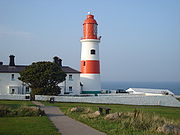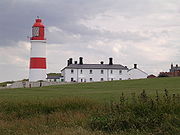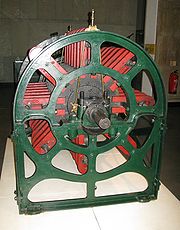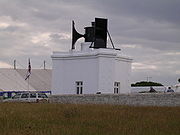
Souter Lighthouse
Encyclopedia



Lighthouse
A lighthouse is a tower, building, or other type of structure designed to emit light from a system of lamps and lenses or, in older times, from a fire, and used as an aid to navigation for maritime pilots at sea or on inland waterways....
located in the village of Marsden
Marsden, Tyne and Wear
Marsden is a suburb in South Shields, North East England, located on the North Sea coast.The original village of Marsden, was demolished in the 1960s due to the risk of erosion from the encroaching shoreline. What remains are five rows of Victorian terraced houses, which were originally built to...
in South Tyneside
South Tyneside
South Tyneside is a metropolitan borough in Tyne and Wear in North East England.It is bordered by four other boroughs - Newcastle upon Tyne and Gateshead to the west, Sunderland in the south, and North Tyneside to the north. The border county of Northumberland lies further north...
, Tyne and Wear
Tyne and Wear
Tyne and Wear is a metropolitan county in north east England around the mouths of the Rivers Tyne and Wear. It came into existence as a metropolitan county in 1974 after the passage of the Local Government Act 1972...
, England.
History
The lighthouse is located on Lizard Point at Marsden, but takes its name from Souter Point, which is located a mile to the south. This was the intended site for the lighthouse, but it was felt that Lizard Point offered better visibility, as the cliffs there are higher, so the lighthouse was built there instead. The Souter Lighthouse name was retained in order to avoid confusion with the then recently built Lizard LighthouseLizard Lighthouse
The Lizard Lighthouse is a lighthouse in Lizard Point in Cornwall, United Kingdom, built in 1752. A light was first exhibited from that point in 1619, but demolished in 1630. Trinity House took responsibility for the station in 1771...
in Cornwall
Cornwall
Cornwall is a unitary authority and ceremonial county of England, within the United Kingdom. It is bordered to the north and west by the Celtic Sea, to the south by the English Channel, and to the east by the county of Devon, over the River Tamar. Cornwall has a population of , and covers an area of...
.
Designed by James Douglass
James Nicholas Douglass
Sir James Nicholas Douglass, FRS, , was an English civil engineer, a prolific lighthouse builder and designer, most famous for the design and construction of the fourth Eddystone Lighthouse, for which he was knighted....
and opened in 1871, the lighthouse was built due to the dangerous reefs directly under the water in the surrounding area. In one year alone - 1860 - there were 20 shipwrecks. This contributed to making this coastline the most dangerous in the country with an average of around 44 shipwrecks per every mile of coastline.
Souter Lighthouse was the first to use alternating electric current
Alternating current
In alternating current the movement of electric charge periodically reverses direction. In direct current , the flow of electric charge is only in one direction....
, the most advanced lighthouse technology of its day. Douglass also designed the fourth incarnation of the Eddystone Lighthouse
Eddystone Lighthouse
Eddystone Lighthouse is on the treacherous Eddystone Rocks, south west of Rame Head, United Kingdom. While Rame Head is in Cornwall, the rocks are in Devon and composed of Precambrian Gneiss....
off the coast of Plymouth
Plymouth
Plymouth is a city and unitary authority area on the coast of Devon, England, about south-west of London. It is built between the mouths of the rivers Plym to the east and Tamar to the west, where they join Plymouth Sound...
.
The 800,000 candle power light was generated using carbon arcs
Arc lamp
"Arc lamp" or "arc light" is the general term for a class of lamps that produce light by an electric arc . The lamp consists of two electrodes, first made from carbon but typically made today of tungsten, which are separated by a gas...
and not a standard filament bulb and could be seen for up to 26 miles. The electricity was generated using a steam engine located in the engine house.
The lighthouse today
Today owned by the National TrustNational Trust for Places of Historic Interest or Natural Beauty
The National Trust for Places of Historic Interest or Natural Beauty, usually known as the National Trust, is a conservation organisation in England, Wales and Northern Ireland...
and open to the public, the lighthouse's engine room, light tower and keeper's living quarters are all on view. There is also an outdoor play area, Trusty Club and indoor activities to accommodate young visitors. Two of the former lighthouse keepers' cottages are used as National Trust holiday cottages.
The lighthouse was decommissioned in 1988, but continued to serve as a radio navigation beacon up until 1999 when it was finally closed.
The lighthouse is said to be haunted and has even featured on British TV's Most Haunted
Most Haunted
Most Haunted is a British paranormal documentary reality television series. The series was first shown on 25 May 2002 and ended on 21 July 2010. It was broadcast on Living and presented by Yvette Fielding. The programme was based on investigating purported paranormal activity...
ghost hunting programme.
Foghorn

Foghorn
A foghorn or fog signal or fog bell is a device that uses sound to warn vehicles of hazards or boats of the presence of other vehicles in foggy conditions. The term is most often used in relation to marine transport...
has seen many changes over the years. When the lighthouse was first built, a single horn of a clay and iron pipe design was provided. This was replaced after a few years by twin horns to the same design, angled so as to spread the noise up and down the coast. By World War II
World War II
World War II, or the Second World War , was a global conflict lasting from 1939 to 1945, involving most of the world's nations—including all of the great powers—eventually forming two opposing military alliances: the Allies and the Axis...
, these had been superseded by twin Rayleigh trumpets. Finally, in the early 1960s, these in turn were replaced by the present-day diaphone fog horns. A reminder of their predecessors can be seen at the seaward corners of the foghorn station.
The horn produced a five-second blast every 30 seconds in poor weather up until 1988, when the lighthouse and foghorn were taken out of service by Trinity House.
The foghorn remains in working order and is sounded on special occasions throughout the year, most notably during the monthly Engine Room Day, which is held at the lighthouse during the summer months.

